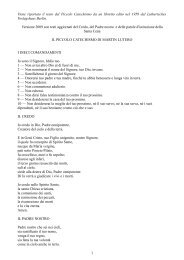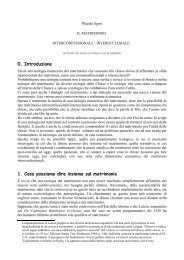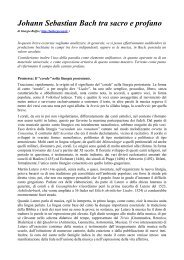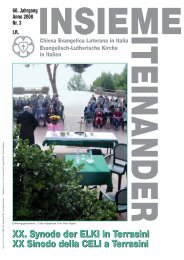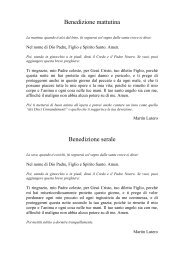Il dialogo ecumenico e interreligioso: quale futuro? - Nemesistemi
Il dialogo ecumenico e interreligioso: quale futuro? - Nemesistemi
Il dialogo ecumenico e interreligioso: quale futuro? - Nemesistemi
Create successful ePaper yourself
Turn your PDF publications into a flip-book with our unique Google optimized e-Paper software.
CONVERTIRSI INSIEME A DIO IN CRISTO<br />
Questa conversione comincia con se stessi (non con quella dell altro) 1 . La conversione delle<br />
Chiese nel <strong>dialogo</strong> è sempre conversione a Dio, non conversione di qualcuno all altra Chiesa 2 .<br />
"Non ci si converte da soli" o non ci si salva da soli , tale sarebbe l opportunità di grazia offerta<br />
nel <strong>dialogo</strong>? Si comincia sempre con il riferimento conversionale a Cristo 3 . La priorità della<br />
conversione delle Chiese a Cristo si esprime nell adesione di una Chiesa al movimento <strong>ecumenico</strong><br />
verso la riconciliazione piena tra i cristiani 4 . Si è talvolta evocato questo ritorno a Cristo come una<br />
dimensione verticale del movimento <strong>ecumenico</strong> nascente 5 . La via della conversione ecclesiale a<br />
Dio in Cristo si attua poi- concretamente tramite la metodologia del <strong>dialogo</strong>, tramite l'impegno<br />
della collaborazione mutua ed il coinvolgimento nella testimonianza cristiana comune 6 . Ogni<br />
conversione è -comunque- una 'teshuvah': invocata dalla tradizione ebraica, un 'ritorno al Signore<br />
Dio' 7 . Questa conversione al Signore che ci riporta al 'Dio unico', Padre di tutti, senza restringere la<br />
visuale sul Cristo soltanto, essa è conversione per la riconciliazione: dalla teshuvah, al capro<br />
espiatorio, al Yom kipur -fino alla perplessità giudaica sul 'venerdì santo' dei cristiani 8 .<br />
Riconoscere che questo pentimento è presente nell interlocutore significa considerarlo un giusto<br />
nella compassione divina verso tutti 9 .<br />
1 W. Kasper, The Joint Declaration on the Doctrine of Justification. Cause for Hope, in «Centro pro Unione», 2000 n° 57, p. 6: «It has also become<br />
clear that the primary purpose of dialogue is not to change one s partner, but to recognize one s own deficits and learn from one another. Conversion<br />
does not begin with the conversion of the other, but with one s own conversion. Thus it is better to consider what steps I can make towards the partner<br />
than to encourage the dialogue partner to make certain steps which he or she cannot make at this time. Such excessive demands, such as a demand for<br />
Eucharistic communion here and now, are less of a help than a hindrance to the discussion. On the other hand, considering what steps I can take<br />
towards the partner can encourage him or her to dare to take a few steps as well».<br />
2 J. Dupuis, Dialogue interreligieux, in AA. VV., Dictionnaire de théologie fondamentale, Paris 1985, p.263 : «Le dialogue ne sert donc pas de simple<br />
moyen en vue d'une fin ultérieure. Ni d'un côté ni de l'autre, il ne tend pas à la du partenaire à la tradition religieuse de l'autre; il tend<br />
plutôt à une conversion plus profonde de l'un et de l'autre vers Dieu. Car le même Dieu parle au coeur de chacun des partenaires, et le même Esprit est<br />
à l'oeuvre en tous. A travres le témoignage réciproque, c'est le même Dieu qui interpelle les partenaires l'un par l'autre. <strong>Il</strong>s deviennent ainsi, peut-on<br />
dire, l'un par l'autre un signe menant à Dieu.La fin propre du dialogue interreligieux est en dernière analyse, la conversion commune des chrétiens et<br />
des membres des autres traditions religieuses au même Dieu, celui de Jésus Christ, qui les appelle ensemble en les interpellant les uns vers les<br />
autres».<br />
3 J. -M. R. Tillard, The Necessary Dimension of Ecumenism, in «Origins», 1976 n° 16, p. 251: «This is what William Temple, Archbishop of<br />
Canterbury, was preaching in Oxford 50 years ago, when the ecumenical movement was still at its beginning. After a quite long explanation of the<br />
role of the Holy Spirit in the renewal of Christian life, he added: "You must begin with Jesus Christ. The way to find his power in your heart is to be<br />
perpetually turning your eyes towards the objective revelation there given on the stage of history. Jesus is not only the revelation of the Spirit; he is<br />
the source of hat Spirit to us. Into our, as in the being of the Godhead, the Holy Spirit proceeds not only from the Father from the Father through the<br />
Son. This power which develops in our hearts is the response which God calls out from our hearts by the revelation given in his Son, and you cannot<br />
know the power of the Holy Spirit in its fullness except by the companionship of Jesus Christ. (Christian Faith and Life, London 1931, 96)».<br />
4 <strong>Il</strong> Papa Paolo VI lo fa per esempio- per dare l indirizzo e l interpretazione della celebrazione dell Anno Santo nel 1974: Paolo VI, Apostolorum<br />
Limina, nº VII, in «Anno Santo», 1974 nº 9-10, p. 223: «Praeterea commonefacimus ipsum Concilium Vaticanum II docere omne studium et opus<br />
huius reconciliationis christianorum sicut et omnem verum occumenismum necessario proficisci debere ex interiore aliquo animi mutatione, quoniam<br />
ipsa communionis christianae cupiditas nascitur ac maturescit, ex spiritus renovàtione, ex sui ipsius abnegatione, ex plena amoris exercitatione, ex<br />
fidelitate, quae veritati revelatac servatur. <strong>Il</strong>la autem in re prorsus agitur verissimeque efficitur totus oecumenicus motus, ad quem catholica Ecclesia,<br />
quantum potest, adhaeret et per quem Ecclesiae atque Communitates cum Apostolica Sede nondum plane coniunctae conquirunt et appetunt<br />
perfectam eam communionem, quam exoptaverat Christus. Munus namque atque officium Ecclesiae totius est iunctionem hanc restituere in integra<br />
Ecclesiarum communione. Annus gratiae ergo hoc sensu prae se fert opportunitatem peculiaris paenitentiae ob christianorum discidia, occasionem<br />
renovationis tamquam altioris experientiae ipsius vitae sanctimoniae in Christo, progressionem ad optatam illam reconciliationem per crebriores<br />
collocutiones atque solidam adiutricem christianorum operam in procurando orbis salute: «et ipsi in nobis unum sint, ut credat mundus»».<br />
5 K. Raiser, The Nature and Purpose of Ecumenical Dialogue, in «The Ecumenical Review», July, 2000: «Obviously, thirty years ago ecumenical<br />
dialogue was a new undertaking and the affirmations about the bases and aims of ecumenical dialogue remained relatively general and tentative. Both<br />
texts seem to oscillate between a concept of dialogue as a means to reach agreement and understanding, or to search together for a deeper<br />
understanding of the truth; and an understanding of dialogue as an expression and manifestation of the real, even though limited, communion that<br />
already exists between the churches by virtue of the common baptism. In the development of ecumenical dialogue within the World Council of<br />
Churches this dialectic is well known since the commission on Faith and Order, at the third world conference in Lund in 1952, made the deliberate<br />
shift from the method of comparative ecclesiology to the christological method emphasizing the vertical, over against the horizontal, dimension in<br />
ecumenical dialogue».<br />
6 CONCILIO ECUMENICO VATICANO II, Decreto "Unitatis Redintegratio", Città del Vaticano 1965, nº 6, 7, 8; nella ultima enciclica di Giovanni<br />
Paolo II, Ut unum sint, Città del Vaticano 1995, e. g. nº 42, si parla della conversione non delle Chiese ma dei 'cristiani'; stranamente, poi, sotto la<br />
testata "Quanta est nobis via?", viene leggermente modificato il modo di esprimersi, evocando il '<strong>dialogo</strong> di conversione' di tutte le comunità con il<br />
Padre (nº 82), introducendo la parte dell enciclica sul ruolo del Papa in seno al cammino <strong>ecumenico</strong>.<br />
7 Cfr COLLOQUIO DI CAMALDOLI, Venite ritorniamo al Signore, in «Vita monastica», 1988 nº 174-175.<br />
8 M. Cunz, Lettura cristiana della teshuvah ebraica, ibidem, pp. 8-21; M. Viterbi Ben Horin, <strong>Il</strong> capro espiatorio, ibidem, pp. 22-32; E. Kopciowsky,<br />
Yom kippur nella prassi e nella esperienza ebraica, ibidem, pp. 33-46; C. Di Sante, Lettura teologica della liturgia del Venerdì Santo, ibidem, pp. 47-<br />
60; A. Janes, <strong>Il</strong> Venersì Santo vissuto dagli ebrei nella storia, ibidem, pp. 61-73.<br />
9 CELEBRATION DES OBSEQUES DU CARDINAL DECOURTRAY, Prière du grand rabbin Sirat, in «La documentation catholique», 1994 nº<br />
2102, p. 895.<br />
12



